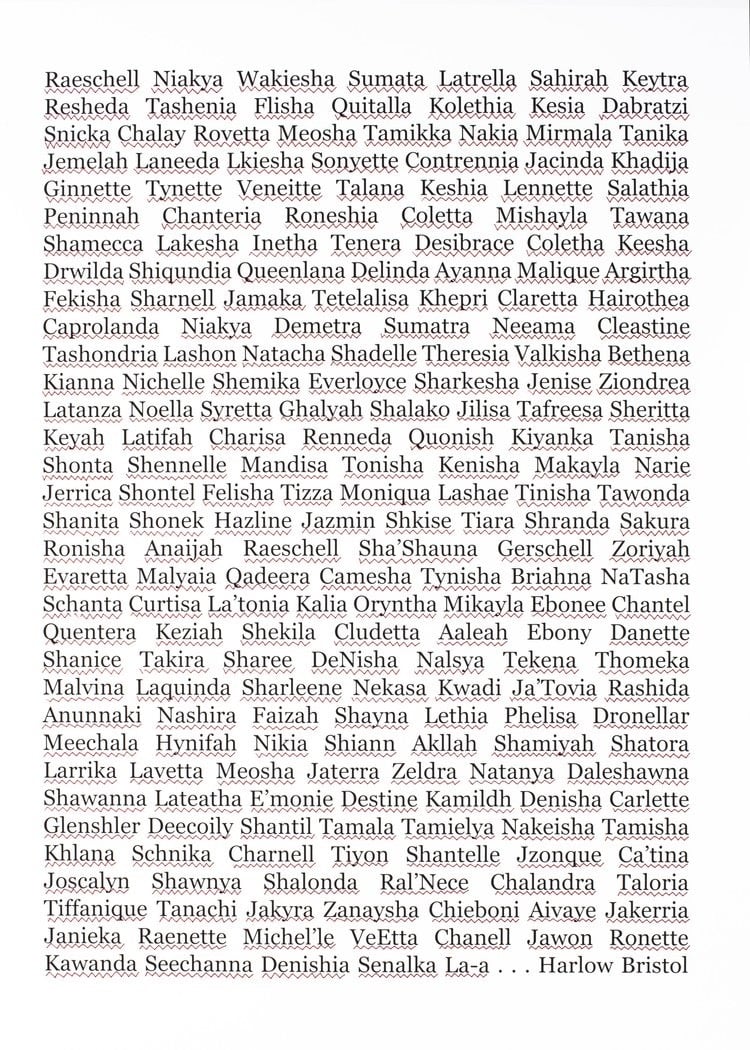
The piece above is part of a series called Pluralism by artist Deborah Roberts — it’s a collage of dozens of Black names marked as misspelled by Microsoft Word’s built-in spell checker. I don’t know about you, but this makes me think about the neutrality of technology, how software is built, who builds it, and for whom it is designed.
I found this via Seeing Black Futures by Jenna Wortham and Kimberly Drew, which is adapted from their forthcoming book, Black Futures. You can check out more of Roberts’ work on her website or on Instagram.
In her post about the book The White Cat and the Monk, Maria Popova uses this great phrase, “uncompetitive purposefulness”, which is one of those things that you hear and you’re like, riiiight, that’s how I want to be living my life.
Written as a playful ode in the ninth century, today the poem lives partway between lamentation and celebration — it stands as counterpoint to our culture of competitive striving and ceaseless self-comparisons, but it also reminds us that the accomplishments of others aren’t to the detriment of our own; that we can remain purposeful about our pursuits while rejoicing in those of others; that we can choose to amplify each other’s felicity because there is, after all, enough to go around even in the austerest of circumstances.
Just this morning I ran across a tweet from Jonny Sun:
if you cheer for people you like instead of envy them the world gets better for you and for them and for everyone involved i promise
And Jenna Wortham’s response:
the cake is big enough for everyone to have a slice. ten slices. the sheet cake can feed us all. infinity cake. infinity rewards and wins.
Every time there’s a new social media app or network that breaks out, someone writes an article about how this new network encourages people to be themselves and have fun without all of the heaviness of other platforms. The latest example of this is Kevin Roose’s NY Times piece about TikTok.
TikTok has none of that. Instead, it’s that rarest of internet creatures: a place where people can let down their guards, act silly with their friends and sample the fruits of human creativity without being barraged by abusive trolls or algorithmically amplified misinformation. It’s a throwback to a time before the commercialization of internet influence, when web culture consisted mainly of harmless weirdos trying to make each other laugh.
In 2016, Jenna Wortham wrote this about Snapchat for the NY Times:
Its entire aesthetic flies in the face of how most people behave on Facebook, Instagram and Twitter — as if we’re waiting to be plucked from obscurity by a talent agent or model scout. But Snapchat isn’t the place where you go to be pretty. It’s the place where you go to be yourself, and that is made easy thanks to the app’s inbuilt ephemerality.
In 2013, Mat Honan wrote this about Vine:
It built a ground up culture that feels loose, informal, and — frankly — really fucking weird. Moreover, most of what you see there feels very of-the-moment. Sure, there’s plenty of artistry that goes into making six second loops, and there are volumes of videos with high production values. But far more common are Vines that serve as windows into what people are doing right now.
Implicit in these pieces is the idea that there’s something intrinsic to these apps/networks that makes them hew closer to real life and/or lightheartedness than older and bigger platforms…the ephemerality of Snapchat, the ease of shooting a Vine video, the fun filters and templates of TikTok. Some part of that is surely true, but what if being small and new is the thing that makes these networks fun? As I wrote in response to Wortham’s article a couple of years ago:
Blogs, Flickr, Twitter, Vine, and Instagram all started off as places to be yourself, but as they became more mainstream and their communities developed behavioral norms, the output became more crafted and refined. Users flooded in and optimized for what worked best on each platform. Blogs became more newsy and less personal, Flickr shifted toward professional-style photography, Vine got funnier, and Twitter’s users turned toward carefully crafted cultural commentary and link sharing. Editing worked its way in between the making and sharing steps.
TikTok probably feels a lot like Flickr or Twitter in the early days, where everyone is exploring and the users are all kind of doing the same things with it. As networks get bigger, they reach a point where there isn’t just one big group exploring the same space together. Instead, you have many big groups who have different goals and desires that all need to fit under one roof (essentially, politics becomes necessary)…and that can get messy, particularly when the companies running these apps want to appeal to the widest possible audience for capitalization purposes.
Novelty is probably the biggest factor though. TikTok is fun because it’s new. When you join up, you get new superpowers and flexing those abilities gives the old brain a shot of dopamine, particularly when the flexing is social. Later, when many of the social possibilities have been explored and even exploited, fun becomes harder to come by. Even Twitter can still be fun — see the replies to Wortham’s recent tweet about fave NYC moments — but the templates for interaction on the platform have long since been set in stone. It would be very surprising if a large & mature social network came along that didn’t also get less fun and “real” as it developed. That would be a special achievement.
From the NY Times, the excellent Jenna Wortham on How I Learned to Love Snapchat. This bit caught my eye:
Its entire aesthetic flies in the face of how most people behave on Facebook, Instagram and Twitter — as if we’re waiting to be plucked from obscurity by a talent agent or model scout. But Snapchat isn’t the place where you go to be pretty. It’s the place where you go to be yourself, and that is made easy thanks to the app’s inbuilt ephemerality.
I wonder if Snapchat’s intimacy is entirely due to the ephemerality and lack of a “fave-based economy”. Blogs, Flickr, Twitter, Vine, and Instagram all started off as places to be yourself, but as they became more mainstream and their communities developed behavioral norms, the output became more crafted and refined. Users flooded in and optimized for what worked best on each platform. Blogs became more newsy and less personal, Flickr shifted toward professional-style photography, Vine got funnier, and Twitter’s users turned toward carefully crafted cultural commentary and link sharing. Editing worked its way in between the making and sharing steps. In 2013, Mat Honan wrote of Vine:
It built a ground up culture that feels loose, informal, and — frankly — really fucking weird. Moreover, most of what you see there feels very of-the-moment. Sure, there’s plenty of artistry that goes into making six second loops, and there are volumes of videos with high production values. But far more common are Vines that serve as windows into what people are doing right now.
Sounds familiar, right? I’m almost positive that when Instagram was first blowing up, similar things were written about it in comparison to Flickr. Now, as Wortham notes, Instagram is largely a place to put your heavily curated best foot forward. But scroll back through time on anyone’s Instagram and the photos get more personal and in-the-moment. Even Alice Gao’s immaculately crafted feed gets causal if you go back far enough.
Although more than a year older than Vine and fewer than two years younger than Instagram, Snapchat is a relatively young service that the mainstream is still discovering. It’ll be interesting to see if it can keep its be-yourself vibe or if users tending toward carefully constructing their output is just something that happens as a platform matures.
Jenna Wortham talked to a bunch of people about intimate texts they send and concludes that Everybody Sexts.
I think that everybody sexts. Not everyone sends nude photos, of course, for a variety of reasons. But many people I’ve talked to define a sext as anything sent with sexual intent, be it a suggestive Gchat exchange, a racy photo, a suggestive Snapchat, or even those aqua-blue droplets of sweat emoji.
I asked people I knew — and many I didn’t — to talk to me about sexts and the stories behind them, the risks, perceived and real, and why they did it, knowing that they could be shared beyond their control. Lastly, I asked them to share a nude that they had sent to someone. And so many people did, without hesitation, or requiring anything in exchange. I was floored by their openness, and the expanse of human emotions and experiences on display. What I discovered, mainly, is that sexting - like anything else done on our phones - was mostly just meant to be fun, for fun, grown folks doing what grown folks do.
NSFW.






Stay Connected